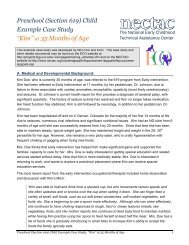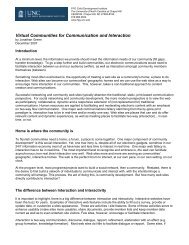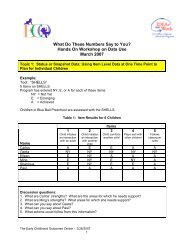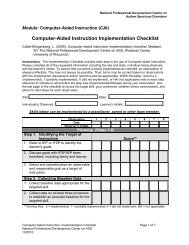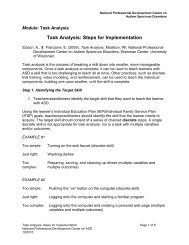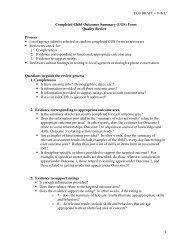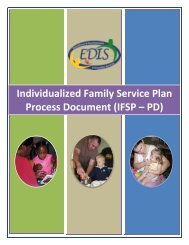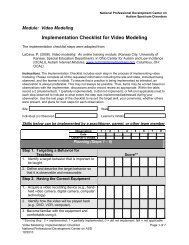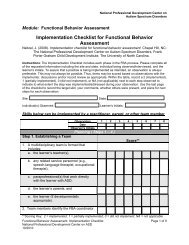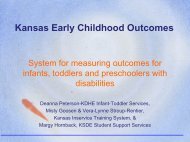goal attainment scaling - National Professional Development Center ...
goal attainment scaling - National Professional Development Center ...
goal attainment scaling - National Professional Development Center ...
You also want an ePaper? Increase the reach of your titles
YUMPU automatically turns print PDFs into web optimized ePapers that Google loves.
Goal Attainment Scaling<br />
GOAL ATTAINMENT SCALING<br />
PROCEDURE AND ILLUSTRATIONS<br />
Goal <strong>attainment</strong> <strong>scaling</strong> (GAS) is a system for assessing progress children and youth with<br />
Autism Spectrum Disorders (ASD) make on individual <strong>goal</strong>s across a specified time period.<br />
These <strong>goal</strong>s are drawn from Individualized Education Programs (IEPs) or Individualized Family<br />
Service Plans (IFSPs) and established by teachers, related services professionals, family<br />
members, and in some cases the individual with ASD. In this process, staff from the <strong>National</strong><br />
<strong>Professional</strong> <strong>Development</strong> <strong>Center</strong> on ASD (NPDC-ASD) collaborate with teachers/practitioners<br />
to identify three IEP/IFSP <strong>goal</strong>s that have the highest priority for the individual with ASD and<br />
establish a five-point scale to measure child/student progress. An illustration of the five-point<br />
scale is found in the table below.<br />
Table 1. Example Goal Attainment Scale<br />
Level<br />
Goal 1:<br />
Of<br />
Uses questions<br />
Attainment<br />
Much less than<br />
expected<br />
-2<br />
Somewhat less<br />
than expected<br />
-1<br />
Expected level<br />
of outcome<br />
0<br />
Somewhat<br />
more than<br />
expected<br />
+1<br />
Much more<br />
than expected<br />
+2<br />
Comments<br />
When given a model and<br />
prompted, will ask<br />
questions of adults.<br />
When prompted, will ask<br />
questions of adults during<br />
50% of the opportunities<br />
presented.<br />
Independently asks<br />
questions to obtain<br />
information from adult in<br />
classroom during 80% of<br />
opportunities presented.<br />
Independently uses<br />
questions with at least<br />
two different adults in<br />
classroom during 80% of<br />
opportunities presented.<br />
Independently asks<br />
questions of adults in<br />
classroom and in at least<br />
one other context during<br />
100% of opportunitites.<br />
Goal 2:<br />
Completes work<br />
assigned<br />
independently<br />
Requires teacher prompts<br />
on at least 75% of the<br />
tasks assigned for<br />
independent work time.<br />
Completes 50% of work<br />
assigned during specified<br />
work time with<br />
appropriate supports.<br />
Independently completes<br />
work assigned during<br />
specified independent<br />
work time with<br />
appropriate supports for<br />
80% of work sessions.<br />
Independently completes<br />
work and puts away<br />
materials after work task<br />
is completed for 80% of<br />
work sessions.<br />
Independently completes<br />
tasks, puts materials<br />
away, and tells teacher<br />
he/she is done for 100%<br />
of work sessions.<br />
Goal 3:<br />
Engages in playful<br />
social interaction with<br />
peers during play<br />
period<br />
Primarily is alone,<br />
unengaged, and<br />
inattentive to peers during<br />
recess.<br />
Plays alone in close<br />
proximity to peers and<br />
watches their play for<br />
50% of play period during<br />
recess.<br />
During recess, plays with<br />
at least one peer for 30%<br />
of the play period.<br />
During recess, routinely<br />
plays with at least one<br />
peer for at least 50% of<br />
the play session.<br />
During recess, routinely<br />
plays with two peers for<br />
at least 50% of the play<br />
session.<br />
(from Cardillo & Choate, 1994)<br />
<strong>National</strong> <strong>Professional</strong> <strong>Development</strong> <strong>Center</strong> on ASD 1<br />
January 23, 2009
Goal Attainment Scaling<br />
Procedure for Developing a Goal Attainment Scale for Children and Youth with ASD<br />
1. Select three IEP/IFSP <strong>goal</strong>s that have high priority for the child/student with ASD. These<br />
<strong>goal</strong>s should be scaleable, in that a continuum of outcomes is identifiable. An example of a<br />
scaleable <strong>goal</strong> is: “Participant uses a question to obtain information in different contexts.”<br />
Dichotomous <strong>goal</strong>s which are answered as either “yes” or “no” should not be used. An<br />
example of a dichotomous <strong>goal</strong> is: “Learner makes an appointment with a vocational<br />
rehabilitation counselor.”<br />
2. Assign each <strong>goal</strong> an abbreviated title and in accompanying documentation, cross reference<br />
the actual <strong>goal</strong> from the IEP or IFSP. For example, a longer behavioral objective such as, “In<br />
the classroom, the learner will independently ask questions to obtain information 8 out of 10<br />
opportunities,” could be modified to the title, “Uses questions.”<br />
3. Specify the levels of <strong>attainment</strong> according to the numbering on the scale, which ranges from<br />
-2 to +2 with 0 being the expected outcome of the <strong>goal</strong>. The GAS will be completed in the<br />
fall and spring of the academic year. Specific information related to the scoring of each <strong>goal</strong><br />
is described below.<br />
a. The <strong>goal</strong> from the IEP or IFSP is the expected outcome for the objective which<br />
appears at the middle or “0” point on the continuum of outcomes. In the example<br />
above, the “0” on the continuum is that the learner asks questions 80% of the time or<br />
8 out of 10 opportunities. The baseline or initial functioning level of the learner for a<br />
particular <strong>goal</strong> could be the -2 designation (much less than expected) on the<br />
continuum of Goal Attainment Guide.<br />
b. Progress that is slightly below or slightly above the expected outcomes should be<br />
specified as -1 (somewhat less than expected) or +1 (somewhat more than<br />
expected). In the example above, the -1 on the continuum might be that the learner<br />
asks questions only 6 out of 10 opportunities. The + 1 on the continuum might be<br />
that the learner asks questions 8 out of 10 opportunities.<br />
c. Progress that is much less or much more than expected should be designated for -2<br />
(much less than expected) or +2 (much more than expected). In our example, the +2<br />
on the continuum might be that the learner asks questions every time the opportunity<br />
arises or 10 out of 10 times.<br />
4. Each of these <strong>scaling</strong> steps should be completed for the three IFSP/IEP <strong>goal</strong>s. To complete<br />
this process, NPDC-ASD staff will meet with teachers/practitioners to prioritize <strong>goal</strong>s and<br />
explain the need to predict a continuum of outcomes for individual children and youth with<br />
ASD.<br />
5. Goal Attainment Scaling will be completed by NPDC staff and teachers/practitioners in the<br />
fall and again in the spring to assess student/child progress on expected outcomes for the<br />
three selected <strong>goal</strong>s.<br />
References<br />
Cardillo, J. E., & Choate, R. O. (1994). Illustrations of <strong>goal</strong> setting. In T. Kiresuk, A. Smith, & J.<br />
Cardillo, (Eds.). Goal <strong>attainment</strong> <strong>scaling</strong>: Applications, theory, and measurement (pp. 15-<br />
37). Hilldale, NJ: Lawrence Erlbaum Associates.<br />
<strong>National</strong> <strong>Professional</strong> <strong>Development</strong> <strong>Center</strong> on ASD 2<br />
January 23, 2009



